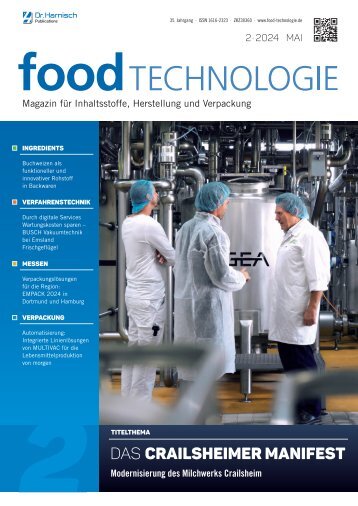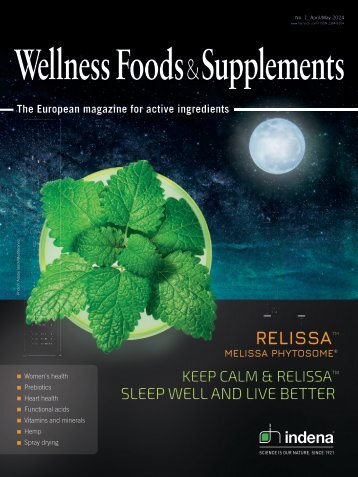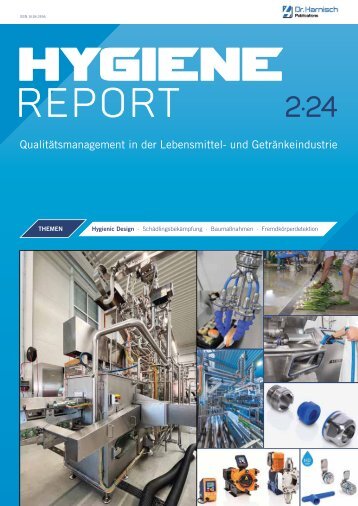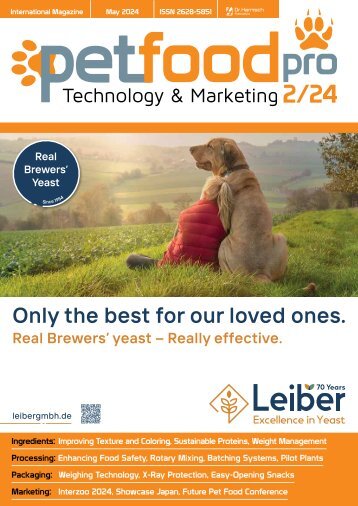food Marketing & Technology 2/2022
- Text
- Harnischcom
- Germany
- Packaging
- Ingredients
- Processing
- Coconut
- Consumers
- Products
- April
- Marketing
- Efficiency
Ingredients An
Ingredients An Innovative look to the Future, Rising to the Plant-Based Challenge Demand for meat alternatives based on vegetable proteins has been rising steadily in recent years – and all signs point to continued growth. According to Allied Market Research, the European market for meat substitutes is expected to be worth ,549.09 million by 2027 – up from ,387 million in 2019. 1 That represents a compound annual growth rate of 7.9 per cent. While those who follow vegan and vegetarian diets continue to look for enjoyable plant-based foods, the biggest driver of current market growth is flexitarians – people who want to reduce their meat consumption for health, ethical or environmental reasons. A survey conducted for the EU-funded Smart Protein Project and published in November 2021 found that 30 per cent of Europeans now consider themselves to be flexitarian. 2 The Smart Protein Project survey also found that 46 per cent of European consumers were eating less meat than they did during the previous year. Almost 40 per cent said they intended to eat fewer meat-based products in the future, and a resounding 86 per cent said yes in answer to the following question: “Imagine that plant-based meat has become widely available, tasty and affordable at grocery stores, restaurants, butchers and markets. How likely are you to try plant-based meat?” Already, 38 per cent of the survey respondents said they were eating plant-based beef at least one to three times a month, and sometimes daily. Thirty-four per cent were eating plant-based poultry at least one to three times a month, and sometimes daily, while for plant-based pork, fish or seafood, the figure was 31 per cent. 2 Commenting on the survey results, Vinciana Patelou, Director of the ENSA-European Plant-based Foods Association, said: “European consumers’ appetite for plant-based foods is here to stay, as shown by the number of Europeans who say they want to eat more plant-based alternatives to dairy and meat in the future.” Highly receptive to new product concepts, butchers and meatprocessing companies can reach this consumer group with plantbased concepts that mimic their old favorites but allow them to embrace the new dietary lifestyle they are aiming for. “Consumers have been showing increasingly individual needs for years, and the desire for new products, especially in the plant-based segment, is great,” says Katharina Haack, Product Manager Health & Nutrition, GoodMills Innovation GmbH. On a geographical basis, the Smart Protein Project noted in its March 2021 Plant-Based Food Sector Report that during 2020, Germany had the highest plant-based food and beverage sales overall, followed by the UK, Spain, Italy and France. 3 In terms of plant-based meat products only, the UK led the way, while Germany also experienced “huge growth”, the report noted. No room for compromise However, despite the apparent widespread consumer appetite for plant-based foods, there is an important hurdle that anyone developing new products has to overcome – how to deliver an enjoyable meat or fish-like texture. If the mouthfeel isn’t right, consumers will not purchase again. Texture is the key to successful alternatives, and it is an area where manufacturers cannot afford to compromise. The ideal is to be able to reproduce the original product in such a way that no major differences in texture can be perceived. This is called “meat mimicking” – the art of recreating bite and mouthfeel for an authentic taste experience. Processors therefore need to pay close attention to the fibrosity and other sensory characteristics of the plant ingredients they choose, whatever the desired product concept may be. GoodMills Innovation has long been involved in the creation of plant-based proteins and has developed a hasslefree solution that allows food producers to overcome texture issues with ease. Its new VITATEX® range is convincing both in terms of authenticity and texture, and is simple to process too. 10 food Marketing & Technology • April 2022
Ingredients Available in a range of options, it can be used to successfully replace meat in all sorts of conventional pork, beef, poultry and fish-based applications. A simple swap With VITATEX®, it is easy for meat processing plants to produce plantbased alternatives. The texturates exhibit such close parallels to conventional meat mass that manufacturers can use the same machines to produce meat-free, patties, nuggets or cutlets as they do for meat processing. The texturates are pre-swollen and can simply be further processed to the required size in a cutter or mincer, just as a regular meat-based minced mass would be. This means that no major manufacturing investment in new equipment is required. Although the outstanding feature of VITATEX® is its meat-like fibrous texture, this is not the whole story. As with all foods, it is the overall combination of appearance, mouthfeel and taste that must convince the consumer. Therefore, alongside texture, the VITATEX® developers have paid close attention to taste, aroma and appearance. With some vegetable texturates, off-notes can represent a challenge, and cereal or earthy notes have to be minimized or masked. GoodMills Innovation therefore works with selected contract farmers to source the best raw materials with defined quality characteristics and uses careful blends of selected flavors and spices to achieve extremely convincing results. Versatile options With consumers more keen than ever to explore different types of plantbased foods, the GoodMills Innovation range includes texturates from different protein bases that enable a variety of end results to be achieved. Alongside wheat and soy variants, VITATEX® is available in pea-based options to suit different product concepts and positionings. Wheat and soy extrudates are already well established in the plant-based arena, while peas combine regionality, sustainable cultivation and tradition, so are particularly attractive for target groups that make their purchasing decisions very consciously. “Innovative product concepts require versatile raw materials, which then enable technological, sensory and nutritional innovations,” says Katharina Haack. “Depending on the raw material base, our texturates have different protein contents and granulations, which form different textures. Meat mimicking to suit the desired result can be achieved and the sensory properties of the products can be optimized.” For plant-based diets in particular, protein content is highly relevant from a nutritional perspective, and depending on the raw material, the protein content of VITATEX texturates varies between 50 and 75 per cent. This allows similar nutritional values as in traditional meat, poutry and fish preparations to be achieved. In terms of other sensory perameters, the texturates have different, lighter and darker shades of yellow, and each achieves a specific sensory sensation in the final product. Long, coarser fibers and short, finer fibers can be achieved, as well as a chunky mouthfeel, such as that of minced meat. It is also possible to combine different texturates to suit the desired end product result. For processors looking for advice on which texturates would work best in specific applications, the GoodMills experts are on hand to help. “Based on our experience with texturates, we are more than happy to give customers advice on the selection of the best texturates for every application,” says Katharina Haack. fmt 1) https://www.alliedmarketresearch. com/europe-meat-substitute-market- A09806#:~:text=The%20Europe%20meat%20 substitute%20market,highest%20share%20 in%20the%20market. [Accessed 24 March 2022] 2) https://proveg.com/wp-content/ uploads/2021/11/Final-webinar-slides_Smart- Protein-European-Consumer-Survey.pdf [Accessed 24 March 2022] 3) https://smartproteinproject.eu/wp-content/ uploads/Smart-Protein-Plant-based-Food- Sector-Report_-Webinar-slides.pdf [Accessed 25 March 2022] food Marketing & Technology • April 2022 11
- Seite 1 und 2: 2/22 Vol. 36 • 31377 ISSN 0932-27
- Seite 3 und 4: Editorial Rewarding Moments There a
- Seite 5 und 6: Vol. 36 • 31377 ISSN 0932-2744 Co
- Seite 7 und 8: Cover Story The key to their flexib
- Seite 9: Cover Story THE LIGHTLINE PICKERLIN
- Seite 13 und 14: Ingredients of the Department of Bi
- Seite 15 und 16: Ingredients temperature: at tempera
- Seite 17 und 18: Ingredients Hacking the food supply
- Seite 19 und 20: Transforming global food production
- Seite 21 und 22: Events potential partners and suppl
- Seite 23 und 24: Processing The Sachsenmilch Leppers
- Seite 25 und 26: Processing PLANT BASED PRODUCT INNO
- Seite 27 und 28: Processing TOMRA’s sorters detect
- Seite 29 und 30: Processing Measurement Technology:
- Seite 31 und 32: Processing installed base are autom
- Seite 33 und 34: ai164822761615_ASH228 INTL_Food_Mar
- Seite 35 und 36: Processing Packaging We bring colou
- Seite 37 und 38: Processing Energy Efficiency up to
- Seite 39 und 40: Events Processing technologies - am
- Seite 41 und 42: Events “Smart Impulses for a Digi
- Seite 43 und 44: Events builds trust. Networked prod
- Seite 45 und 46: Events Anuga FoodTec, Cologne, Hall
- Seite 47 und 48: Events Anuga FoodTec, Cologne, Hall
- Seite 49 und 50: Marketing undesirable. The purpose
- Seite 51 und 52: Marketing DataPhysics Instruments i
- Seite 53 und 54: Axial split modular casing on steel
- Seite 55 und 56: Packaging diverse, inspiring and ex
- Seite 57 und 58: Josef Rettenmaier 1924 - 2022 Josef
- Seite 59 und 60: Events Connect with nutraceutical e
- Seite 61 und 62:
Innovations in Meat Vol. 36 • 313
Unangemessen
Laden...
Magazin per E-Mail verschicken
Laden...
Einbetten
Laden...
























































































































































































































































































